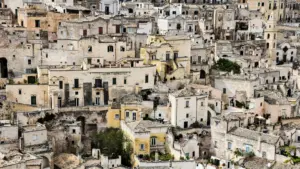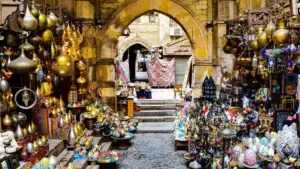Breakfast. At this time of year, the light in Lecce shifts tone and mood: less harsh sun, softer angles, more golden melancholy. It’s no longer the dry, white summer light that scorches everything. It’s more photogenic, gentler on the Lecce stone, like an Italian film from the 70s. The city seems to hush, letting stone, light, and slow pace speak.
We start the day with a guided walking tour of Lecce’s old town, a city remarkable for its rich Baroque heritage. This style, exuberant and theatrical, flourished in the 17th and 18th centuries—just after the Renaissance, which came with a desire to shake off architectural corsets. In Lecce, Baroque becomes especially expressive: forms in motion, details carved to the last centimetre, façades like stone tapestries. Among other highlights, we’ll see Piazza Sant’Oronzo with its partially visible Roman amphitheatre; the monumental Piazza del Duomo dominated by the cathedral and elegant bell tower; and the Basilica of Santa Croce, a jewel of Salento Baroque whose façade defies sobriety.
After the tour, lunch awaits, a small lesson in regional identity. Don’t hesitate to order orecchiette alle cime di rapa—homemade pasta with bitter greens, garlic, and a touch of chilli. It’s the most southern flavour of Italian cuisine: intense, unvarnished, and full of character. If you see pittule (fried dough balls, sometimes with cod or vegetables) or puccia salentina (round bread stuffed as the cook pleases), dive in. No judgment here except for those who don’t dip their bread in the sauce.
If you opt for the optional trip to Otranto, prepare for a little odyssey on the other side of the heel of Italy. The journey is worth it: winding secondary roads between olive groves, dry stone walls, and hamlets that seem forgotten by time.
Otranto isn’t just a pretty coastal town—it’s a stone summary of everything that passed through here: Greeks, Romans, Byzantines, Normans, Turks… and that’s just the first thousand years. You’re greeted by its Aragonese castle, sturdy and watchful, still seeming to guard the port as if awaiting another Ottoman invasion. The old town’s streets lead nowhere useful, and that’s the point: getting lost is part of the plan.
But the real highlight, literally and figuratively, is the cathedral. From outside, sober. Inside… the floor will stop you in your tracks. A gigantic 12th-century mosaic covers the nave with biblical scenes, mythological creatures, elephants, Adam and Eve, and a tree of life straight out of a medieval novel illustrated by a very imaginative, very sleep-deprived monk. It’s as fascinating as it is puzzling, and you’ll look at it with the same mix of admiration and bafflement as a Game of Thrones tapestry made by monks.
If there’s time, take a walk along the seafront, watch the Adriatic crashing against the rocks, and remember you’re at Italy’s easternmost point. Albania lies just beyond, closer than you think.
Back in Lecce, reconnect with those who stayed behind wandering plazas—probably with more pasticciotti in hand.
If you stay in Lecce for the afternoon, congratulations: you’re part of the calm camp, the mapless explorers who understand that sometimes the best visits are the unplanned ones.
You might revisit a morning corner at a gentler pace or get lost in less-travelled areas, where balconies overflow with geraniums and façades look like half-dismantled sets. In Lecce, the everyday mixes with the theatrical: a woman hanging laundry might have more stage presence than a Verdi opera.
It’s a good time to poke around papier-mâché workshops—that’s right, papier-mâché taken seriously here—or shops selling everything from Byzantine icons to carved wooden toothbrushes. And if the strange calls you: some local antique dealers sell furniture as ornate as churches, and religious figurines that could star in a horror movie or a procession, depending on the angle.
But let’s be honest: you’ll end up sitting in a square, probably with a pasticciotto in hand. Another one, yes. Filled with classic cream or maybe chocolate or amarena, because cultural duty demands tasting all flavours. To accompany, a caffè leccese made as the rules dictate: strong espresso, ice, and that almond syrup that reminds you of condensed milk—but without the theological complications. Sweet, refreshing, and absolutely deserved.
Slowly, Lecce softens in the afternoon light—that gentle, melancholic glow the city seems to have learned to ration wisely. Nobody rushes here. No one is in a hurry. And that, by itself, is a kind of luxury.
In the evening, it’s time to find a table. Though dinner isn’t included, you’re in a place where good food needs no map or recommendation. Try risotto al nero di seppia, a risotto made with cuttlefish ink that gives it a striking black colour and a rich, briny taste. Don’t miss sagne ’ncannulate, a twisted local pasta, or involtini—thin slices of veal, pork, or chicken rolled with cheese, herbs, ham or vegetables, cooked on the stove or baked, sometimes served with sauce or white wine. They’re a bit like flamenquines (breaded meat rolls from Andalusia) or spring rolls, but bursting with the authentic flavours of Bari. If you want something simpler, a board of local cured meats and cheeses with warm bread and house wine. If the day was long, let the after-dinner linger.”

